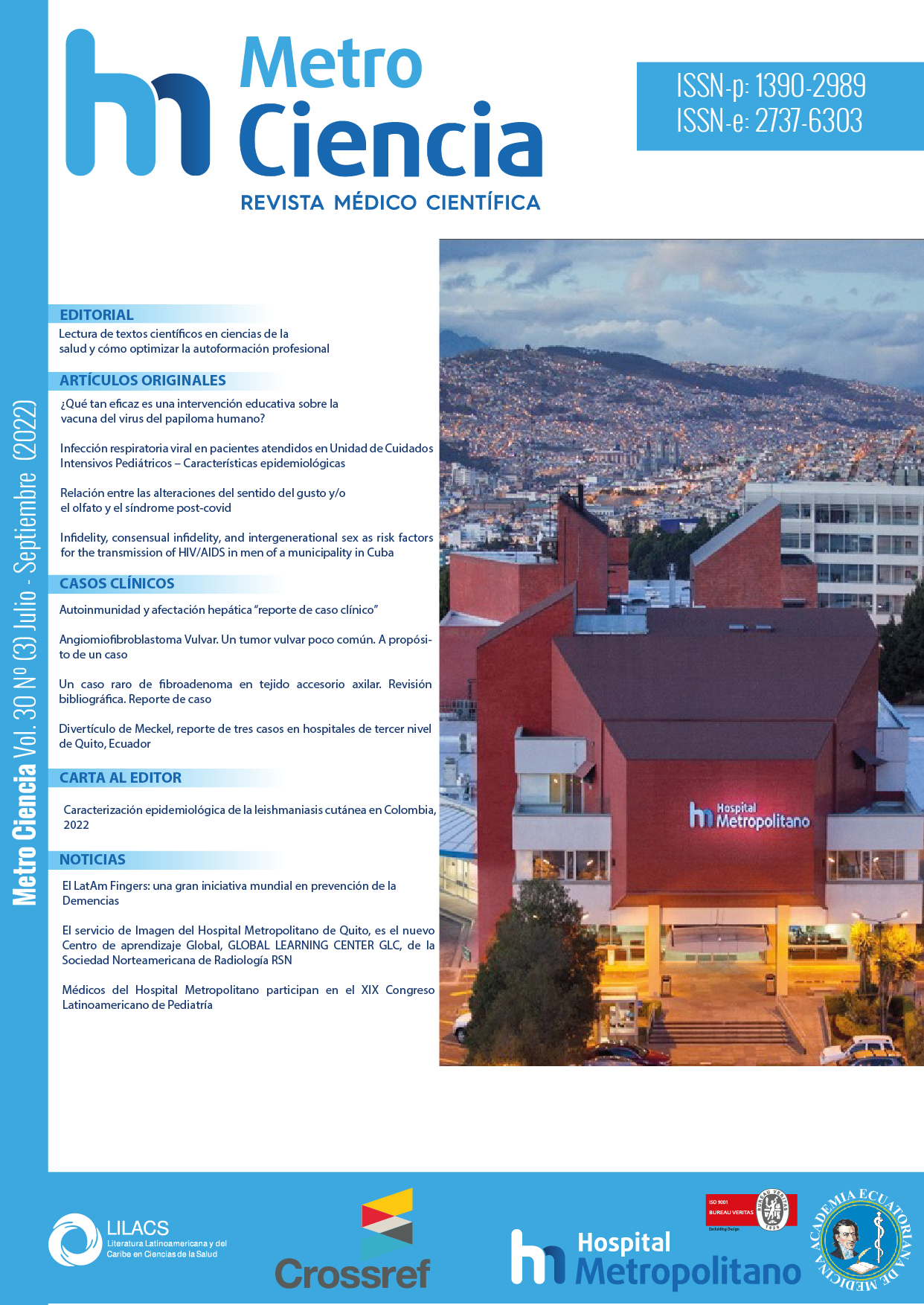Relación entre las alteraciones del sentido del gusto y/o el olfato y el síndrome post-covid
DOI:
https://doi.org/10.47464/MetroCiencia/vol30/3/2022/29-43Palabras clave:
COVID-19 persistente, Covid crónico, Covid post-agudo, hiposmia, anosmia, disgeusia, ageusiaResumen
Introducción: La COVID-19 se caracteriza por generar cuadros de diversa severidad durante la fase aguda de la enfermedad, conllevando eventualmente al desarrollo de secuelas o a su vez de una enfermedad denominada en inglés como “Long Covid” Materiales y métodos: Se procedió a realizar un estudio de tipo descriptivo, mediante la realización de una encuesta a 121 participantes entre marzo y abril del 2022, los cuales contaron con un diagnóstico previo de COVID-19. Posterior a ello, se extrajeron los datos para realizar el análisis estadístico y la exposición de los resultados. Resultados: El 12.4% y el 9.1% ha presentado persistencia de síntomas olfativos y gustativos por al menos 12 meses, respectivamente. Desde los 3 meses hasta por al menos los 12 meses, los síntomas más comunes fueron: astenia, cefalea, alteraciones de la memoria y disnea. Se observó además que el 23.1% se recuperó completamente de los síntomas crónicos tras recuperar el gusto y/o el olfato por completo, mientras que el 20.6% que no se ha recuperado de estos últimos, ha persistido con otros síntomas de la COVID-19. Conclusiones: Los casos catalogados como leves durante la fase aguda de la enfermedad son los más afectados por la COVID-19 crónica. Las personas que presentaron alteraciones del gusto y/o el olfato y que se recuperaron completamente de los mismos, también lo hicieron del resto de síntomas de la COVID-19; lo que no se pudo observar en aquellos que no se han recuperado de estas alteraciones.
Descargas
Citas
Coronavirus [Internet]. WHO. 2022 [cited 4 July 2022]. Available from: https://www.who.int/health-topics/coronavirus#tab=tab_1.
Monroy J, Torres O. Efectos de los coronavirus del síndrome respiratorio agudo grave (SARS-CoV) y del síndrome respiratorio del Medio Oriente (MERS-CoV) en el sistema nervioso. ¿Qué esperar del SARS-CoV-2? | Biomédica [Internet]. Revistabiomedica.org. 2020 [cited 4 July 2022]. Available from: https://revistabiomedica.org/index.php/biomedica/article/view/5682/4736
CDC. Symptoms of COVID-19 [Internet]. Centers for Disease Control and Prevention. 2022 [cited 2022 Jul 4]. Available from: https://www.cdc.gov/coronavirus/2019-ncov/symptoms-testing/symptoms.html
Rodriguez-Sevilla JJ, Güerri-Fernádez R, Bertran Recasens B. Is there less alteration of smell sensation in patients with Omicron SARS-CoV-2 variant infection? Front Med (Lausanne) [Internet]. 2022;9:852998. Available from: http://dx.doi.org/10.3389/fmed.2022.852998
A clinical case definition of post COVID-19 condition by a Delphi consensus, 6 October 2021 [Internet]. Who.int. World Health Organization; 2021 [cited 2022 Jul 4]. Available from: https://www.who.int/publications/i/item/WHO-2019-nCoV-Post_COVID-19_condition-Clinical_case_definition-2021.1
Dysautonomia International. Webinar: Dysautonomia Symptoms in Long Haul COVID 19 [Internet]. Vimeo; 2020 [cited 2022 Jul 4]. Available from: https://vimeo.com/442593497
Thompson EJ, Williams DM, Walker AJ, Mitchell RE, Niedzwiedz CL, Yang TC, et al. Risk factors for long COVID: analyses of 10 longitudinal studies and electronic health records in the UK [Internet]. bioRxiv. 2021. Available from: https://www.medrxiv.org/content/10.1101/2021.06.24.21259277v2.full.pdf
Alex SS, Danielle Ellis BS. Study finds 67% of individuals with long COVID are developing dysautonomia [Internet]. News-medical.net. 2022 [cited 2022 Jul 4]. Available from: https://www.news-medical.net/news/20220501/Study-finds-6725-of-individuals-with-long-COVID-are-developing-dysautonomia.aspx
Ortiz-Ibarra FJ, Simón-Campos JA, Macías-Hernández A, Anda-Garay JC, Vázquez-Cortés J, García-Méndez J, et al. COVID-19: prevención, diagnóstico y tratamiento. Recomendaciones de un grupo multidisciplinario [Internet]. Org.mx. [cited 2022 Jul 4]. Available from: https://medicinainterna.org.mx/article/COVID-19-prevencion-diagnostico-y-tratamiento-recomendaciones-de-un-grupo-multidisciplinario/
Do vaccines protect from long COVID? [Internet]. Thelancet.com. 2022 [cited 2022 Jul 4]. Available from: https://www.thelancet.com/pdfs/journals/lanres/PIIS2213-2600(22)00020-0.pdf
Ayoubkhani D, Bermingham C, Pouwels KB, Glickman M, Nafilyan V, Zaccardi F, et al. Trajectory of long covid symptoms after COVID-19 vaccination: community based cohort study. BMJ [Internet]. 2022 [cited 2022 Jul 4];377:e069676. Available from: https://www.bmj.com/content/377/bmj-2021-069676
Society, American Thoracic. Long COVID Patient Fact Sheet [Internet]. Thoracic.org. 2022 [cited 2022 Jul 4]. Available from: https://www.thoracic.org/patients/patient-resources/resources/long-covid.pdf
Yelin D, Moschopoulos CD, Margalit I, Gkrania-Klotsas E, Landi F, Stahl J-P, et al. ESCMID rapid guidelines for assessment and management of long COVID. Clin Microbiol Infect [Internet]. 2022 [cited 2022 Jul 4];28(7):955–72. Available from: http://dx.doi.org/10.1016/j.cmi.2022.02.018
Hintschich CA, Fischer R, Hummel T, Wenzel JJ, Bohr C, Vielsmeier V. Persisting olfactory dysfunction in post-COVID-19 is associated with gustatory impairment: Results from chemosensitive testing eight months after the acute infection. PLoS One [Internet]. 2022;17(3):e0265686. Available from: http://dx.doi.org/10.1371/journal.pone.0265686
Wei G, Gu J, Gu Z, Du C, Huang X, Xing H, et al. Olfactory dysfunction in patients with Coronavirus disease 2019: A review. Front Neurol [Internet]. 2021;12:783249. Available from: http://dx.doi.org/10.3389/fneur.2021.783249
Tong JY, Wong A, Zhu D, Fastenberg JH, Tham T. The prevalence of olfactory and gustatory dysfunction in COVID-19 patients: A systematic review and meta-analysis. Otolaryngol Head Neck Surg [Internet]. 2020;163(1):3–11. Disponible en: http://dx.doi.org/10.1177/0194599820926473
Lechien JR, Chiesa-Estomba CM, De Siati DR, Horoi M, Le Bon SD, Rodriguez A, et al. Olfactory and gustatory dysfunctions as a clinical presentation of mild-to-moderate forms of the coronavirus disease (COVID-19): a multicenter European study. Eur Arch Otorhinolaryngol [Internet]. 2020;277(8):2251–61. Disponible en: http://dx.doi.org/10.1007/s00405-020-05965-1
Fortunato F, Martinelli D, Iannelli G, Milazzo M, Farina U, Di Matteo G, et al. Self-reported olfactory and gustatory dysfunctions in COVID-19 patients: a 1-year follow-up study in Foggia district, Italy. BMC Infect Dis [Internet]. 2022;22(1):77. Disponible en: http://dx.doi.org/10.1186/s12879-022-07052-8
Nguyen NN, Hoang VT, Lagier J-C, Raoult D, Gautret P. Long-term persistence of olfactory and gustatory disorders in COVID-19 patients. Clin Microbiol Infect [Internet]. 2021;27(6):931–2. Disponible en: http://dx.doi.org/10.1016/j.cmi.2020.12.021
Backman I. How effects on the brain can produce long COVID [Internet]. Yale.edu. Yale School of Medicine; 2022 [citado el 31 de mayo de 2022]. Disponible en: https://medicine.yale.edu/news-article/how-effects-on-the-brain-can-produce-long-covid/
Douaud G, Lee S, Alfaro-Almagro F, Arthofer C, Wang C, McCarthy P, et al. SARS-CoV-2 is associated with changes in brain structure in UK Biobank. Nature [Internet]. 2022;604(7907):697–707. Disponible en: https://www.nature.com/articles/s41586-022-04569-5.pdf
Brown K, Yahyouche A, Haroon S, Camaradou J, Turner G. Long COVID and self-management [Internet]. Thelancet.com. 2022 [cited 2022 Jul 4]. Available from: https://www.thelancet.com/journals/lancet/article/PIIS0140-6736(21)02798-7/fulltext
Publicado
Cómo citar
Número
Sección
Licencia
Derechos de autor 2022 Elías Eduardo Celi Yépez , Javier Alejandro Astudillo Mayorga, Christopher Sebastián López Rodríguez, Aarón Alberto Guzmán Tello, Jessica Nicole Ordóñez Reyna, Juan Carlos Padilla Espín

Esta obra está bajo una licencia internacional Creative Commons Atribución 4.0.











